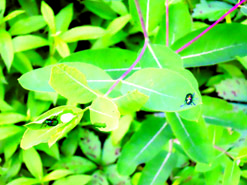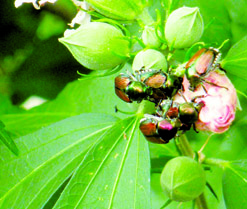Fighting Japanese Beetles

I was meandering through my garden at sunset when I spotted the beautiful iridescent green spots on a milkweed. Juvenile Japanese beetles, starting to hatch from last year’s buried grubs. For the next six weeks, it will be a battle between these wily bugs and me.
The 3/8th of an inch hard shell beetles are eating machines, devouring more than 200 plant species. Once they turn from grubs into beetles, they set off a scent that says “let’s party” to other Japanese beetles, yet another reason why you shouldn’t crush the bugs, no matter how tempting.
If you don’t see them, you’ll know you have them when your plant leaves turn into lace.
Prior to the beetle’s accidental introduction into the United States, the Japanese beetle was found only on the islands of Japan, isolated by water and kept in check by its natural enemies. The beetles entered the country as grubs in soil on Japanese iris roots. By 1920, eradication programs were dropped. The beetle proved to be too prolific a breeder.
One of the popular options to eliminate these voracious bugs is Japanese beetle traps, which I don’t recommend. Those are basically pheromone-laced paper bags that attract Japanese beetles. The challenge is the bags don’t catch all of them so having more Japanese beetles in your garden means more potential grubs to hatch out next year.
If you insist on using Japanese beetle traps, make sure you place them at the edge of your property and down wind.
What has worked very well for me over the years is dropping them in a can of soapy water early morning, while they are still sluggish. I pop the soapy water-filled coffee can underneath the plant branches, then shake them. The bugs fall into the water without my touching them.
According to University of Missouri Extension Service, Pyrethrins and Spinosad are effective and non-toxic sprays to try to manage Japanese beetles.
For a long-term solution, my brother in Virginia has treated his lawn with milky spores. He has dozens of crepe myrtles, one of Japanese beetles favorite munchies. According to him, Japanese beetle grubs eat the spores; get sick; die and, in the process, release more milky spores. It can take several years to eliminate the Japanese beetles, not counting whether your neighbors have treated their lawns.
Believe it or not, there are plants Japanese beetles avoid. The typical kind of plant that will help to drive away Japanese beetles will be strong smelling and may taste badly to the insect. Some plants that deter Japanese beetles include garlic, rue, tansy, catnip, chives, white chrysanthemums, leeks, onions, marigolds, white geraniums and larkspur.
There are also plants that Japanese beetles skip or only munch on towards the end of their season. I assume these are just not tasty plants: begonias, caladiums, common lilacs, common pear, tulip tree, flowering dogwood, forsythia, hydrangea, hickory, magnolia, persimmon and most oak trees.
Ok, time to soap up and start picking off those pesky bugs.
Charlotte Ekker Wiggins is a beekeeper, gardener and sometimes cook. Published by El Dorado Springs Sun once in print and online with author’s permission. Copyright 2017, all rights reserved. This column may not be reprinted, republished or otherwise distributed without author’s permission. Contact Charlotte at gardeningcharlotte at gmail dot com.

EATING MACHINES – Adult Japanese beetles dining on a rose of Sharon flower, one of the rose family favorite Japanese beetle plants. (Photos by Charlotte Wiggins).

A LITTLE ANYTHING IS CUTE? – These are juvenile Japanese beetles munching on a milkweed in my garden.



Facebook Comments